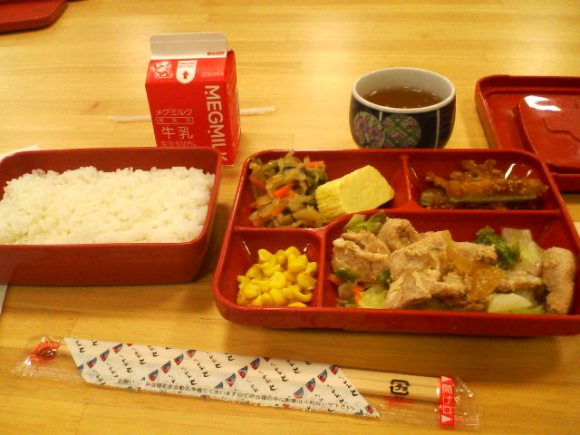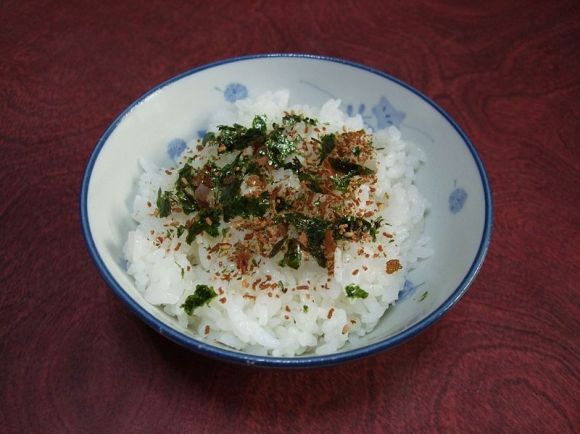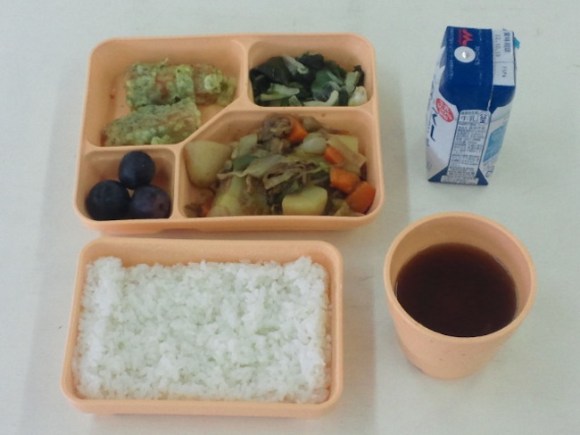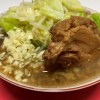
He’s known for his outspoken and often controversial opinions, from saying that civil servants who have tattoos should resign, to denying the forcible recruitment of South Korean “comfort women” during the second world war.
But it was an intense debate about whether students should be allowed to have furikake seasoning with their school lunch that left city mayor Tōru Hashimoto scratching his head this week as he asked the Osaka Board of Education: “What’s wrong with furikake?!”
Cold, unappetising and tasteless is how junior high students in Osaka describe their school lunches. And kids have been voting with their chopsticks, leaving lunches uneaten. With 70 percent of students failing to finish their school lunch, the city Board of Education has been discussing ways to get them to clear their plates.
“More students might eat their rice if they could have furikake [with school lunch]”, teachers suggested in a meeting on Tuesday. Mayor Hashimoto then asked in amazement, “Furikake wa dame nan desu ka?”, which translates as “Huh? What’s wrong with furikake?” or “Why can’t they have furikake?”
Furikake is a flaked flavouring that is sprinkled on rice. It comes in all kinds of flavours, but it’s typically fishy with seaweed, and is a popular and effective way to get Japanese kids to eat up their bowl of plain rice.
▼ Furikake: Looks weird, tastes great.
So what’s the problem with furikake? Well, typically, school lunches in Japan are rice-heavy and well-balanced. But furikake is high in salt, and allowing kids to use it might undo the careful balance of the healthy meal they’re being served. On the other hand, some say that the negative effects of higher salt intake might be offset by the benefit of students actually finishing their meals.
School meal uptake in Japan is impressively high, and students are expected to eat the whole thing with no leftovers. But in Osaka, where bringing lunch from home has long been the norm, school lunches are a recent development. In 2011, only 11 percent of junior high students in Osaka were having a “full school lunch” including milk, compared to a national average of 76 percent. Amid concern that some homemade lunches were not healthy enough, school lunches were rolled out across the city.
▼ Iced buns, while delicious, do not a healthy lunch make.
But to keep costs down, lunches in Osaka are prepared elsewhere, refrigerated, and delivered to schools. The problem is, lots of kids don’t like chilled lunch.
▼ And who can blame them? Meat and potato stew, straight from the fridge.
On the furikake question specifically, the debate lasted 10 minutes and did not come to any concrete conclusions; the board decided to consult with experts before taking any further action. Will flaked seasonings be allowed in Osaka’s schools? Hashimoto was insistent that schools must be allowed to decide for themselves without interference from the city government: “If we can’t even let schools decide about furikake…”
Sources: Sankei Shimbun/Yahoo, Naver Matome
Featured image: awatajinja




 Japanese teacher beats up student for making fun of his body by calling him anime character name
Japanese teacher beats up student for making fun of his body by calling him anime character name Japanese people react to reading that “pizza is a vegetable in America”
Japanese people react to reading that “pizza is a vegetable in America” Petition to allow students to choose what they wear to school gathers almost 19,000 signatures
Petition to allow students to choose what they wear to school gathers almost 19,000 signatures Curry restaurants across Japan create social media movement: “Don’t blame the curry!”
Curry restaurants across Japan create social media movement: “Don’t blame the curry!” Anime isn’t like reality: High school days edition
Anime isn’t like reality: High school days edition McDonald’s new Happy Meals offer up cute and practical Sanrio lifestyle goods
McDonald’s new Happy Meals offer up cute and practical Sanrio lifestyle goods Studio Ghibli glasses cases let anime characters keep an eye on your spectacles
Studio Ghibli glasses cases let anime characters keep an eye on your spectacles Super Nintendo World expansion gets delayed for several months at Universal Studios Japan
Super Nintendo World expansion gets delayed for several months at Universal Studios Japan All-you-can-drink Starbucks and amazing views part of Tokyo’s new 170 meter-high sky lounge
All-you-can-drink Starbucks and amazing views part of Tokyo’s new 170 meter-high sky lounge Beautiful Sailor Moon manhole cover coasters being given out for free by Tokyo tourist center
Beautiful Sailor Moon manhole cover coasters being given out for free by Tokyo tourist center More foreign tourists than ever before in history visited Japan last month
More foreign tourists than ever before in history visited Japan last month Kyoto’s 100 Demons yokai monster parade returns!
Kyoto’s 100 Demons yokai monster parade returns! Our reporter takes her 71-year-old mother to a visual kei concert for the first time
Our reporter takes her 71-year-old mother to a visual kei concert for the first time Is the new Shinkansen Train Desk ticket worth it?
Is the new Shinkansen Train Desk ticket worth it? We cooked Japan’s 2,000-yen mail-order Ramen of the Year, but was it worth it?【Taste test】
We cooked Japan’s 2,000-yen mail-order Ramen of the Year, but was it worth it?【Taste test】 Disney princesses get official manga makeovers for Manga Princess Cafe opening in Tokyo
Disney princesses get official manga makeovers for Manga Princess Cafe opening in Tokyo Starbucks reopens at Shibuya Scramble Crossing with new look and design concept
Starbucks reopens at Shibuya Scramble Crossing with new look and design concept Beautiful new Final Fantasy T-shirt collection on the way from Uniqlo【Photos】
Beautiful new Final Fantasy T-shirt collection on the way from Uniqlo【Photos】 Foreign English teachers in Japan pick their favorite Japanese-language phrases【Survey】
Foreign English teachers in Japan pick their favorite Japanese-language phrases【Survey】 Japanese convenience store packs a whole bento into an onigiri rice ball
Japanese convenience store packs a whole bento into an onigiri rice ball We try out “Chan Ramen”, an underground type of ramen popular in the ramen community
We try out “Chan Ramen”, an underground type of ramen popular in the ramen community Studio Ghibli releases Kiki’s Delivery Service chocolate cake pouches in Japan
Studio Ghibli releases Kiki’s Delivery Service chocolate cake pouches in Japan Japan’s bone-breaking and record-breaking roller coaster is permanently shutting down
Japan’s bone-breaking and record-breaking roller coaster is permanently shutting down New definition of “Japanese whiskey” goes into effect to prevent fakes from fooling overseas buyers
New definition of “Japanese whiskey” goes into effect to prevent fakes from fooling overseas buyers Our Japanese reporter visits Costco in the U.S., finds super American and very Japanese things
Our Japanese reporter visits Costco in the U.S., finds super American and very Japanese things Studio Ghibli unveils Mother’s Day gift set that captures the love in My Neighbour Totoro
Studio Ghibli unveils Mother’s Day gift set that captures the love in My Neighbour Totoro Foreign passenger shoves conductor on one of the last full runs for Japan’s Thunderbird train
Foreign passenger shoves conductor on one of the last full runs for Japan’s Thunderbird train Domino’s Japan now sells…pizza ears?
Domino’s Japan now sells…pizza ears? New Japanese KitKat flavour stars Sanrio characters, including Hello Kitty
New Japanese KitKat flavour stars Sanrio characters, including Hello Kitty Kyoto creates new for-tourist buses to address overtourism with higher prices, faster rides
Kyoto creates new for-tourist buses to address overtourism with higher prices, faster rides Sales of Japan’s most convenient train ticket/shopping payment cards suspended indefinitely
Sales of Japan’s most convenient train ticket/shopping payment cards suspended indefinitely Sold-out Studio Ghibli desktop humidifiers are back so Totoro can help you through the dry season
Sold-out Studio Ghibli desktop humidifiers are back so Totoro can help you through the dry season Japanese government to make first change to romanization spelling rules since the 1950s
Japanese government to make first change to romanization spelling rules since the 1950s Ghibli founders Toshio Suzuki and Hayao Miyazaki contribute to Japanese whisky Totoro label design
Ghibli founders Toshio Suzuki and Hayao Miyazaki contribute to Japanese whisky Totoro label design Doraemon found buried at sea as scene from 1993 anime becomes real life【Photos】
Doraemon found buried at sea as scene from 1993 anime becomes real life【Photos】 Tokyo’s most famous Starbucks is closed
Tokyo’s most famous Starbucks is closed One Piece characters’ nationalities revealed, but fans have mixed opinions
One Piece characters’ nationalities revealed, but fans have mixed opinions We asked a Uniqlo employee what four things we should buy and their suggestions didn’t disappoint
We asked a Uniqlo employee what four things we should buy and their suggestions didn’t disappoint Princesses, fruits, and blacksmiths: Study reveals the 30 most unusual family names in Japan
Princesses, fruits, and blacksmiths: Study reveals the 30 most unusual family names in Japan Japanese teacher criticized for attending son’s entrance ceremony instead of her own school’s
Japanese teacher criticized for attending son’s entrance ceremony instead of her own school’s Japanese students’ eyesight the worst in recent years, smartphones and mobile games are blamed
Japanese students’ eyesight the worst in recent years, smartphones and mobile games are blamed Japanese university globalizes with fall start date, governor wants English as official language
Japanese university globalizes with fall start date, governor wants English as official language Human pyramids continue in Kobe schools as injuries mount to 51, mayor’s pleas to stop unanswered
Human pyramids continue in Kobe schools as injuries mount to 51, mayor’s pleas to stop unanswered Japanese school lunch noodles fried so hard that children and teachers chip teeth, go to hospital
Japanese school lunch noodles fried so hard that children and teachers chip teeth, go to hospital Japanese public school to allow male students to wear skirts, chest ribbons as part of uniform
Japanese public school to allow male students to wear skirts, chest ribbons as part of uniform Public schools in Japan’s Saga Prefecture will no longer regulate/check students’ underwear color
Public schools in Japan’s Saga Prefecture will no longer regulate/check students’ underwear color Junior high student shut down 444 school websites to “remind teachers they are incompetent”
Junior high student shut down 444 school websites to “remind teachers they are incompetent” Talented Japanese sixth graders pull off mind-blowing jump-rope routine【Video】
Talented Japanese sixth graders pull off mind-blowing jump-rope routine【Video】 Short video looks at why Japanese students serve their own school lunches, clean their classrooms
Short video looks at why Japanese students serve their own school lunches, clean their classrooms Tokyo public schools will stop forcing students with non-black hair to dye it, official promises
Tokyo public schools will stop forcing students with non-black hair to dye it, official promises Snappy as they look, Japanese school uniforms can be an extremely expensive hassle for parents
Snappy as they look, Japanese school uniforms can be an extremely expensive hassle for parents Female high school students continue to be banned on baseball field at Koshien Stadium in Japan
Female high school students continue to be banned on baseball field at Koshien Stadium in Japan Hi-Chew releases new Japanese School Lunch flavor to stimulate appetites and nostalgia
Hi-Chew releases new Japanese School Lunch flavor to stimulate appetites and nostalgia Japan has an awesome one-person bento box rice cooker, and here’s what we made with ours
Japan has an awesome one-person bento box rice cooker, and here’s what we made with ours
Leave a Reply